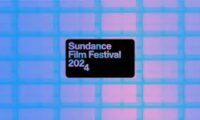PACIFIC RIM: Watch It At Home – Even Michael Bay Might Say “Too Much”
Why isn’t PACIFIC RIM a better movie? It’s a passion project for the tremendously talented co-writer (with Travis Beacham) and director Guillermo del Toro, who’s made both the enjoyably junky Hellboy adventures and the transcendent Pan’s Labyrinth. Del Toro is a man who takes his fantasy and pulp very seriously, and he’s crafted Pacific Rim with almost all the budget he could ever have wanted (reportedly $200M) and obsessive care, and yet the result is so formulaic and predictable that it feels, more than anything else, bland. It’s so far into the head of its fanboy, manga, vintage sci-fi horror mindset (the movie is its own Comic-Con) that it abandons all interest in emotional reality–in humans as individuals. Pacific Rim thinks cardboard is worthwhile so long as it’s phosphorescent CG cardboard.
Pacific Rim‘s mythology is complicated but relatively clear. Before the movie’s main events (i.e., our present), a rift in the ocean floor revealed itself to be a pathway to another dimension. On the other end is a seemingly endless supply of giant monsters (called Kaiju, after the Japanese genre that gave us Godzilla and many others). The Kaiju have been coming through the portal ever since, wreaking havoc in several cities worldwide until mankind discovered a weapon that could beat them: equally massive robots. These robots are so enormous, in fact, that they’re controlled by two synchronized pilots, whose minds have to be intertwined in something called “the drift.” As the years went on, the Kaiju became more colossal and dangerous and the robots had less success in defeating them, leading to official abandonment of the robot program–but one man, Stacker Pentecost (Idris Elba) is leading a last-ditch program based out of Hong Kong to defeat the kaiju by having the remaining robots drop a nuclear bomb right down into the interdimensional portal.
Of course, the pilot Pentecost most needs is Raleigh Becket (Charlie Hunnam), who at one time was part of the program’s ace team, but has been a burnt-out mess since he experienced the death of his brother, who was in the drift with him when a kaiju destroyed their robot and ate him. (Remarkably, Raleigh isn’t an alcoholic, one of the few cliches the script passes up.) Since Raleigh’s brother is gone, the beautiful and brilliant kaiju expert Mako Mori (Rinko Kikuchi) has an assortment of candidates for Raleigh to test as possible partners, but they don’t include herself, because even though she’s always wanted to be a pilot, Pentecost refuses to even let her try, and can you guess who his partner turns out to be? The other important team of pilots is made up of old-timer Hercules Hanson (Max Martini) and his hothead son Chuck (Robert Kazinsky, having a big year between this and his role on True Blood). There are other pilots, but they’re glorified extras; the heroes are rounded out by wacky scientists Newton Geiszler (Charlie Day) and Gottlieb (Burn Gorman).
Warner Bros Marketing has taken some heat in advance of the Pacific Rim opening for what’s considered an ineffectively one-note ad campaign that features nothing but footage of the alien monsters and giant robots battling each other. Indeed, technically there’s about 45 minutes after the extended opening and leading up to the movie’s second half (which is almost entirely devoted to two endless action sequences) that feature actors speaking dialogue to one another. However, all they talk about is, well, alien monsters and giant robots battling each other, so there’s not much variety there either.
Like James Cameron, del Toro is a visionary of technology, an artist who truly believes that there need be no boundaries between high-tech and art, and that the most elaborate and expensive computer-driven tools can be paintbrushes and clay in the right hands. Of the two, clearly del Toro has the more poetic sensibility–one can’t even imagine Cameron creating a film like Pan’s Labyrinth or The Devil’s Backbone. Yet sadly, it’s Cameron who brought lyricism and heart to Avatar, however blunt his hand may have been with them, while Pacific Rim is imprisoned by limited characters and flat dialogue. The fantastic beasts and even the human-driven machines in Cameron’s film had beauty and grace, while del Toro’s creations are just damn big.
With Pacific Rim, del Toro delivers an epic that reminds one of Robert Rodriguez’s overheated genre rehashes like Sin City, Machete and his chapter of Grindhouse. They’re so committed to recreating the aesthetics of cheap, cheesy B-movies (in del Toro’s case, on a massive scale) that it’s all they find room to do. No one in Pacific Rim gets to act (Idris Elba seems to be playing Lance Reddick’s role from Fringe), and although Day, Gorman and del Toro favorite Ron Perlman clown it up in small roles, there isn’t any memorable dialogue or even moments for the characters to act like people. The supposed twists in plot are purely functional, and so are the emotional stakes (Raleigh and Mako have to get over the respective tragedies in their pasts, and Pentecost has a secret tipped off in the very early going). You can almost feel del Toro tapping his foot with impatience, waiting for his gigantic toys to do their next trick–it’s the exact reverse of Joss Whedon’s The Avengers, which despite its basic silliness sparkled when it concentrated on its characters and only became generic when it was CG time. (It’s the emotional emptiness of Pacific Rim, by the way, that allows snobbish critics like A.O. Scott to enjoy it–he considers fantasies like the Dark Knight trilogy to be pretentious, but deliberate meaninglessness is something he can get behind; it’s a movie that knows its place.)
Pacific Rim is certainly technically impressive, but after a summer spent watching superhumans blow up themselves, their foes, and the cities unlucky enough to house them, one only notes dispassionately that the creatures are fanatically detailed, and that there’s eerie beauty in all the neon and phosphorescence. The movie is so dependent on CG backgrounds and set extensions that it’s hard to tell what Guillermo Navarro actually photographed and Andrew Neskoromney and Carol Spier actually designed, but it all looks quite classy and expensive The editing by Peter Amundson and John Gilroy could have done a better job making sense of the battles, while Ramin Djawadi’s score is notably loud.
In a way, Pacific Rim is the logical extension of what this summer’s spectacles have been, almost a pornography of mammoth CG effects pounding each other for over two hours. Its script and sensibility might as well be CG too.




